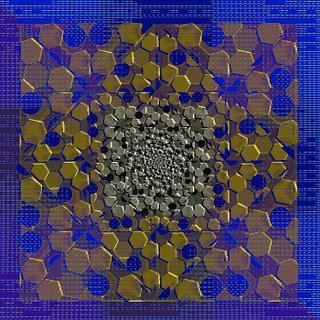
Trechos de uma discussão sobre fractais envolvendo vários artistas e a mim, sobre as propostas e o valor estético de nosso meio de expressão. Como a discussão se deu no âmbito de um mailing list abrangendo vários países, conservei o texto original em inglês.
I just want to remark that I´ve nothing against spirals...except if they are the only understood form of fractal´s excelence. For instance at the new calendar, if you look at the precedent issues you are going to realize that there is only a repetition of the same shape year after year. I got the impression of an art without variations or researches. It produce me the meanings of an art without guts, an art of laze accommodation . But I am prepared to modify my point of view.
***
This is a common complaint about the calendar. However, it sells. So, the calendar people pick what they knowwill sell. It doesn't represent the best of fractal art, nor a diversity of fractal art. It's simply a commercial venture that sells.
***
Thank you for the remarks and corrections. But despite it´s profitable convenience, I could not avoid to observe it´s inherent formal repetition.
***
I agree with you, but spirals must touch something deep in our psyches, maybe because so many occur in nature. Sometimes I challenge myself to do spirals that are not trite.
***
I´m not opening a polemic about spirals and against artists that mostly are doing it. My concern is not with the shape itself, but I make critics on the so intense repetition of a pattern wich is so easy to get with graphic tools. Seldon people is not identifying fractals with nothing else than spirals. The abondance finally becomes vulgar as sunset posters in a teenager´s roon. I do agree very much but I can´t avoid to see some "reduction" in the aesthetical level of researches with fractals.The exuberance and multiple ways we could observe in the creaction of works at the decades of ´80 and at the´90 seems to be reduced and that was about my commentary.
***
I think the idea of "FractalArt" as a genre is a problem in itself, because it implies art that is confined by what has come before (within the genre).The point here being that I think fractals shouldn't be thought of a "genre" or "movement" but simply as a "medium".The other thing, I guess, is that as the number of people who create fractal art increases, the percentage of innovators within that number decreases.
***
Your proposal basically extinguish the discussion that was from beginning attached at the production of fractals as an implied form of "artistic"expression. Most of the recognition of fractals was and is based on the idea that aesthetical qualities were disseminated in the production of "true art works".Thinking on your proposal, the first thing that occours to me is that man really don´t create fractals. It´s a paradox, but if fractals aren´t more than graphical representations of... well... of itself, than we came to the point where to create art with this limited "mediun" is not possible! We cannot to go further than "interesting patterns"!So, we must consider that fractals can be "almost" art, but not quite.
***
My point of view, that I said many times on the late fractal art mailing list and on R-sity forums has more or less relation with post-processing. Or I use post-processing to explain my point of view. All computer graphics is based on mathematics and many special effets, filters, (clouds, particles effects, plants, etc) etc. are fractals or use fractals. In most of the CG softwares (Photoshop, Painter, etc), it is not said as the users just doesn't care but care about the result they want. Only some programs say it clearly and openly and these are the called fractal generators. This also means that the separation line between 'pure' and 'post processed' is a false debate. Have you ever noticed that in Julia and Mandelbrot (some other formulas?), there are zooms where it becomes 'non-fractal' for some colouring methods?
***
I prefer algorithmic art, myself, because the basic images are fundamentally algorithmic. Maybe you could say that the subject matter is algorithmic. Processed photos may use algorithm based methods, but the base image comes from a photograph. Natural media programs like Painter certainly use algorithms, but without the interaction of a human hand, no image occurs. And "algorithmic art" is reasonably easy to say, and has the potential of acquiring the meaning of the art sort of art that we do. So "algorithmic art" is where I prefer to stake out our linguistic territory.
Comments